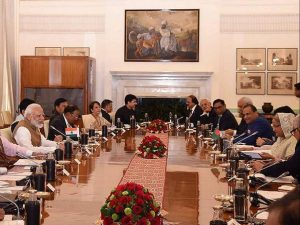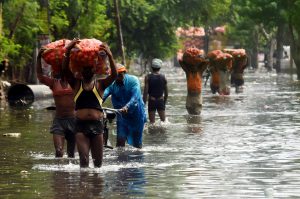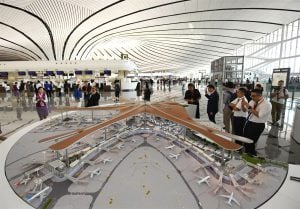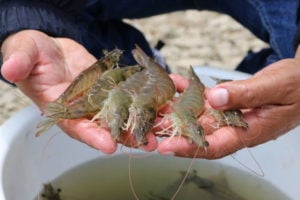Bangladesh is one of India’s closest friends in South Asia. As a part of its Neighbourhood First Policy and Act East Policy, in April, 2017, India offered a line of credit worth USD 4.5 billion to Bangladesh for its infrastructure development related to ports, rail and roads, power supply and civil nuclear energy.
This ‘friendship’ is expected to reach a greater height during the forthcoming visit of the Bangladeshi Prime Minister Sheikh Hasina to New Delhi in the first week of October and offers a significant opportunity for improving livelihoods for riverine communities on both sides of the border. Among other engagements, Hasina will be the chief guest at the India Economic Summit of the World Economic Forum.
During this visit, the two countries are expected to sign a framework agreement on the development and use of inland waterways for water sharing and basin level management of trans-boundary rivers including through cross-border trade and tourism. Instead of a piecemeal approach towards the treatment of inland waterways, this framework agreement is expected to cover all 54 trans-boundary rivers. The framework agreement to harness the trade and economic benefits through inland waterways should also pave ways for a more integrated and inclusive development framework that protects and promotes the existing environmental and social dividends.
Potential of inland waterways
Of the 4,095 kilometres of international border shared between India and Bangladesh, 1,116 kilometres fall under riverine boundaries. The 54 trans-boundary rivers cater to a wide range of ecosystem services including livelihoods that include agriculture, fisheries, tourism. The mighty trans-boundary rivers, such as Ganga/Padma, Brahmaputra/Jamuna, Barak/Meghna, have always been an integral part of bilateral discussions of trans-boundary cooperation either as part of multi-modal connectivity projects or water resource management.
Consequently, the multi-modal logistic terminals in Jogighopa, Assam over the Brahmaputra river and in Haldia, West Bengal over the Ganges/Hooghly river will be instrumental to achieve this vision. The proposed terminal in Joghigopa would enable Bhutanese cargo to avail waterways in India and Bangladesh.
For the first time, an Indian cargo ship carrying 1,000 tonnes of stone aggregates from Bhutan arrived at Narayanganj near Dhaka on July 18, 2019 through via Dhubri in Assam and Chilmari in Bangladesh. This has reduced the transportation time by eight days and travel cost by 30%, thereby bringing down the logistic costs, which is a challenge for efficient conduct of cross-border trade.
The terminal in Haldia will be instrumental in furthering the objectives of the India-Bangladesh Coastal Shipping Agreement, which is expected to be revised to allow port access and other operations of big vessels. This will enable greater coordination of cargo operations between the Haldia port in India and the Mongla port in Bangladesh. Concurrently the operationalisation of the Mongla-Khulna railway line, which is being developed with India’s assistance, will make this route a multi-modal one and will reduce the pressure of cargo movements along the Petrapole/Benapole land border.
In this context, it is important to hasten the operationalisation of the protocol route from Dhulian in West Bengal (India) to Rajshahi in Bangladesh over the Ganga/Padma river. (A protocol route is one under which inland vessels of one country can transit through designated river routes to other country. This is governed by the Protocol on Inland Water Transit and Trade.) This route will connect Northeast India with the eastern and northern parts of India via two other multi-modal logistic terminals – one in Sahibgunj, Jharkhand and the other in Varansi, Uttar Pradesh. Similarly with the construction of the ‘Maitree Setu’ over the Feni river in Sabroom, Tripura, it is necessary to declare Sonamura (Tripura)-Daudkandi (Bangladesh) as a protocol route along the Gomti river.
This bridge will connect Tripura to Bangladesh’s Chittagong port, which is barely 75 kilometres away from Bangladesh border and thus, will act as an international gateway for cargo originating in the Northeast of India. All these initiatives would redefine the transport and transit narrative between India and Bangladesh.
Riverine communities engaged in small-scale agriculture, horticulture and fisheries along these waterways will benefit from market access and a better price for their produce as transportation costs decrease. A benefit often overlooked is that women groups engaged in traditional handicrafts and handlooms in these communities will also get access to and benefit from new trade and market opportunities linked to the inland waterways.
Development of these inland waterways will require new financial and technological investments-most of it in physical infrastructure development. Measures to minimise the negative environmental and social impacts of these infrastructure projects, most of which disproportionately affect indigenous communities and particularly women, should be in place right from the beginning through a consultative and participatory process. This process needs to include cross-border dialogue among communities, infrastructure developers and financiers, civil society and the governments.
People-to-people connectivity via tourism
The agreements on passenger and cruise services signed during PM Hasina’s last visit has already been operationalised with the first trip carrying 19 passengers from Kolkata to Dhaka via the Sundarbans in March 2019, followed by another trip over the Brahmaputra from Pandu to Kolkata via Dhaka. This has opened a new avenue of cultural and heritage tourism, which would contribute to the livelihoods of local riverine communities in tourism-related activities.
With the emerging potential of cross-border tourism, developing Integrated Check Posts at Dawki, Meghalaya and Sabroom, Tripura will not just improve the trade operations across the border but will also facilitate people-to-people connectivity. The crystal clear river of Umngot in Dawki-Jaflong border area and Shnongpdeng a village in Jaintia Hills – located about eight kilometres from the border – are ideal locations for nature and adventure tourism and has the potential to attract tourists from Bangladesh. Similarly, easy access to Chittagong and coastal areas sea will be an exciting experience for the people of Tripura and other Northeastern states of India.
Many indigenous communities and women groups engaged in tourism activities could benefit from community-led sustainable eco-tourism initiatives in potential regions along these waterways.
Time for basin-wide management
Other than transport connectivity, river water sharing has always been a sensitive issue in bilateral discussions between India and Bangladesh. Of the 54 trans-boundary rivers shared between the two countries, there is only one treaty signed so far – the Ganga Waters Treaty, 1996. Sharing of water resources of Teesta and Feni rivers was discussed in the last meeting of the Joint River Commission in 2010 but no progress since then. There is also a demand in Bangladesh to upgrade the Joint River Commission to an institutional system of basin management for better coordination and planning.
While the River Basin Management Bill (2018) is pending before the Indian parliament, the demand for a bilateral institution for basin wide management of trans-boundary rivers needs to be reviewed with consideration. Considering the loss of life and property faced by both countries annually due to floods, it makes sense to propose a basin level mechanism for an integrated and inclusive planning.
Read: One law to rule India’s rivers
The proposed framework agreement on the management of trans-boundary rivers should be a first step in that direction. Other than scientific inputs, the operational aspects of this agreement should include the economic potential and environmental sustainability of trans-boundary rivers through cross-border trade and tourism which are essential for generating new livelihood opportunities for the riverine communities.
All views are personal.
![<p>The inaugural ceremony of goods transfers from Bhutan to Bangladesh via India, using inland waterways [image courtesy: CUTS International]</p>](https://dialogue.earth/content/uploads/2019/09/Inagural-ceremony-1.jpeg)







